

ROCHESTER RED STAR (May 2024)
ROC DSA Monthly Newsletter | No. 01
The post ROCHESTER RED STAR (May 2024) first appeared on Rochester Red Star.


Socialists in Office Denounce Violent Suppression of Student Protesters at Universities

Democratic socialist State Representative Erika Uyterhoeven (27th Middlesex); Cambridge City Council Member Jivan Sobrinho-Wheeler; Somerville City Council Members Willie Burnley, Jr. and JT Scott; and Medford City Council President Zac Bears, who represent almost a quarter of a million residents released the following statement:
We stand in solidarity with the students practicing peaceful protest at Harvard, MIT, Tufts, Emerson, and Northeastern Universities, as well as all others across the Commonwealth of Massachusetts and the country. We unequivocally condemn the violent repression that the police, university administrators, and elected municipal leaders have exercised toward these students.
Massachusetts, and the Boston area in particular, has long been a cradle of protest and dissent, dating back centuries. These students embrace and honor this history of dissent through their peaceful protests against the ongoing genocide in Gaza and the higher education structures that enable it. Their brave and powerful protest represents a united call to not just end to the ongoing genocide in Gaza but for their universities to divest from institutions that profit from this genocide, Israeli apartheid, and occupation. We are firmly opposed to antisemitism, which has no place in this movement to end the genocide and is part of the same machinery of fear and division that these students are organizing against. We are moved by this multiracial, multigenerational, interfaith movement and these encampments demonstrate the power of solidarity against division and hate. The sowing of division and condemnation of peaceful protest has been a longstanding tactic to undermine social justice movements standing on the correct side of history.
As we approach the 54th anniversary of the Kent State University massacre on May 4, it is disturbing to see university administrations and police replicating the violent suppression that led to that tragedy. We must not repeat this history. Massachusetts is home to over 100 institutions of higher learning with nearly half a million students. We call upon these universities to protect these students’ right to assembly, free speech, and to provide amnesty for students by revoking any retaliatory academic discipline. Universities should be bastions of free speech, but instead we clearly see that our constitutional rights are secondary to universities’ collusion with police as a means of maintaining systems of oppression.
It is important in this moment to remember the reason these students have made the brave decision to protest, which is the ongoing genocide in Gaza. University administrators, government officials, and corporate media outlets seek to reframe the conversation in this moment around students’ right to protest. We must avoid this trap and remain focused on demanding those in power finally adopt what the majority of Americans support – an immediate and permanent ceasefire in Palestine and end to the Israeli occupation.
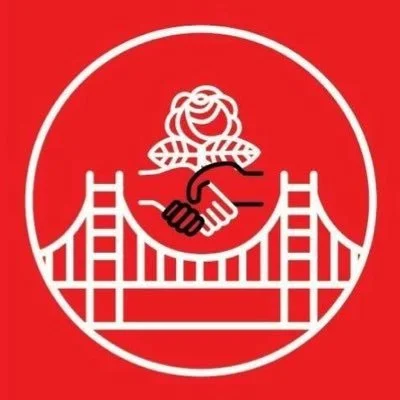

Weekly Roundup: April 30, 2024
Upcoming Events
 Tuesday, April 30 (1:30 p.m. – 8:00 p.m.): Ecosociolists at SFMTA Hearing – Stop the MUNI Fare Increase(In person at 1 Dr. Carlton B. Goodlett Place, Floor 4, Room 400)
Tuesday, April 30 (1:30 p.m. – 8:00 p.m.): Ecosociolists at SFMTA Hearing – Stop the MUNI Fare Increase(In person at 1 Dr. Carlton B. Goodlett Place, Floor 4, Room 400)
 Wednesday, May 1 (10:00 a.m. – 2:00 p.m.): International Workers Day March and Rally (In person at 24th St BART)
Wednesday, May 1 (10:00 a.m. – 2:00 p.m.): International Workers Day March and Rally (In person at 24th St BART)
 Wednesday, May 1 (6:30 p.m. – 9:00 p.m.): New Member Happy Hour (In person at Zeitgeist, 199 Valencia St)
Wednesday, May 1 (6:30 p.m. – 9:00 p.m.): New Member Happy Hour (In person at Zeitgeist, 199 Valencia St)
 Thursday, May 2 (6:00 p.m. – 7:00 p.m.): Palestine Solidarity Working Group (Zoom)
Thursday, May 2 (6:00 p.m. – 7:00 p.m.): Palestine Solidarity Working Group (Zoom)
 Thursday, May 2 (7:00 p.m. – 8:00 p.m.): Labor Board Meeting (Zoom)
Thursday, May 2 (7:00 p.m. – 8:00 p.m.): Labor Board Meeting (Zoom)
 Friday, May 3 (12:00 p.m. – 5:00 p.m.): Office Hours (In person at 1916 McAllister)
Friday, May 3 (12:00 p.m. – 5:00 p.m.): Office Hours (In person at 1916 McAllister)
 Saturday, May 4 (10:00 a.m. – 1:00 p.m.): Jackie Fielder Campaign Mobilization (Meet at Precita Park)
Saturday, May 4 (10:00 a.m. – 1:00 p.m.): Jackie Fielder Campaign Mobilization (Meet at Precita Park)
 Saturday, May 4 (1:00 p.m. – 4:00 p.m.): Homelessness Working Group Sock Distro (Meet at 1916 McAllister St)
Saturday, May 4 (1:00 p.m. – 4:00 p.m.): Homelessness Working Group Sock Distro (Meet at 1916 McAllister St)
 Sunday, May 5 (10:00 a.m. – 1:00 p.m.): Extreme Dean Door Knock Mobilization (Meet at Jefferson Square Park, corner of Turk & Laguna)
Sunday, May 5 (10:00 a.m. – 1:00 p.m.): Extreme Dean Door Knock Mobilization (Meet at Jefferson Square Park, corner of Turk & Laguna)
 Monday, May 6 (6:00 p.m. – 7:30 p.m.): Ecosocialist Monthly Meeting (In person at 1916 McAllister St and on Zoom)
Monday, May 6 (6:00 p.m. – 7:30 p.m.): Ecosocialist Monthly Meeting (In person at 1916 McAllister St and on Zoom)
 Tuesday, May 7 (7:00 p.m. – 8:00 p.m.): Mutual Aid Priority Meeting (Zoom)
Tuesday, May 7 (7:00 p.m. – 8:00 p.m.): Mutual Aid Priority Meeting (Zoom)
 Wednesday, May 8 (6:45 p.m. – 9:00 p.m.): May Chapter Meeting (In person location TBD and on Zoom)
Wednesday, May 8 (6:45 p.m. – 9:00 p.m.): May Chapter Meeting (In person location TBD and on Zoom)
 Saturday, May 11 (5:00 p.m. – 7:00 p.m.): Tenant Organizing Movie Night: “Boom: The Sound of Eviction” (In person at 1916 McAllister)
Saturday, May 11 (5:00 p.m. – 7:00 p.m.): Tenant Organizing Movie Night: “Boom: The Sound of Eviction” (In person at 1916 McAllister)
 Monday, May 13 (6:00 p.m. – 7:30 p.m.): Environmentalism From Below: How Global People’s Movements Are Leading the Fight for Our Planet (Zoom)
Monday, May 13 (6:00 p.m. – 7:30 p.m.): Environmentalism From Below: How Global People’s Movements Are Leading the Fight for Our Planet (Zoom)
Check out https://dsasf.org/events/ for more events.
Events & Actions
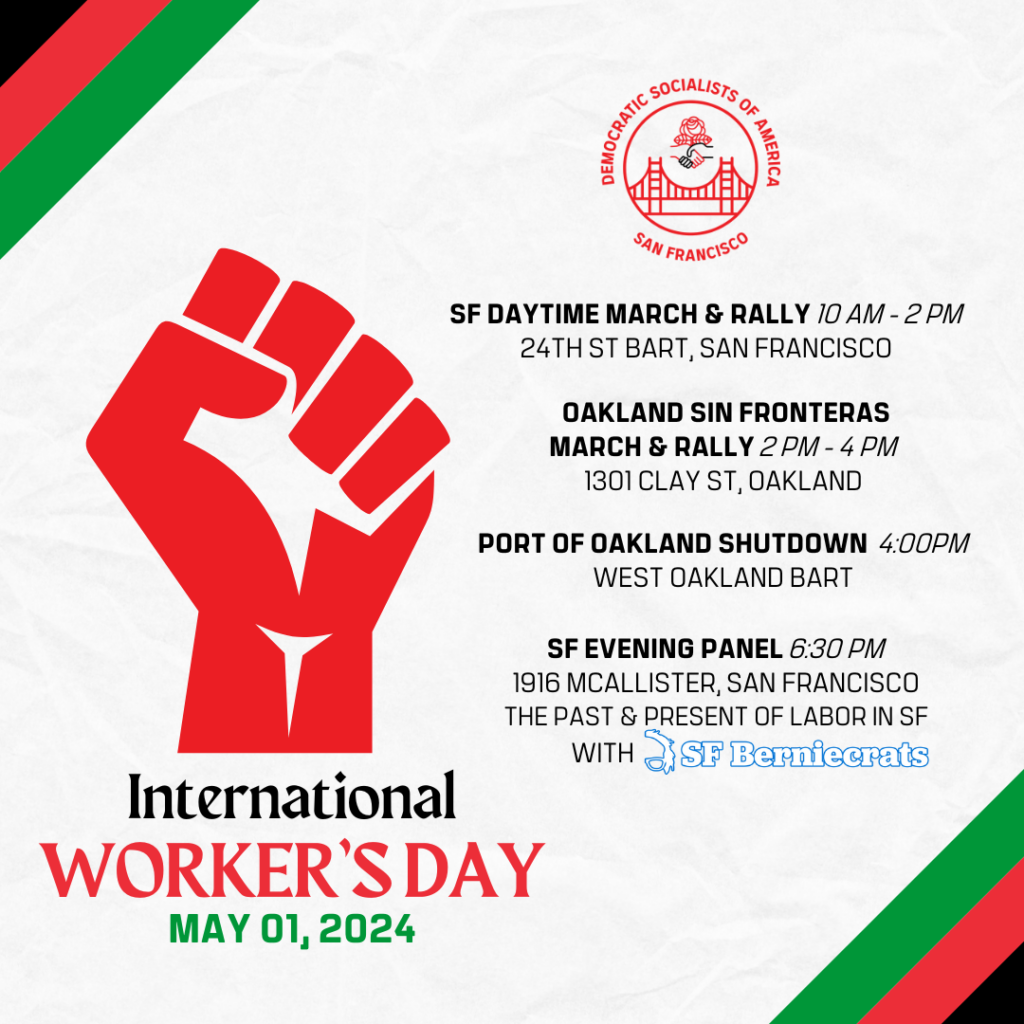
 May Day Action!
May Day Action! 
Wednesday, May 1 is International Workers’ Day, and this year the workers will answer the call of Palestinian labor unions to stand in international solidarity against genocide.
An injury to one is an injury to all! No business as usual!
Join your DSA comrades at any or all of these events
- 10:00 a.m. – 2:00 p.m.: SF Daytime March & Rally at the (24th St BART, SF)
- 2:00 p.m. – 4:00 p.m.: Oakland Sin Fronteras March & Rally (1301 Clay St, Oakland)
- 4:00 p.m.: Port of Oakland Shutdown (Meet at West Oakland BART)
- 6:30 p.m.: SF Evening Panel: The Past & Present of Labor in SF with SF Berniecrats (1916 McAllister, SF)
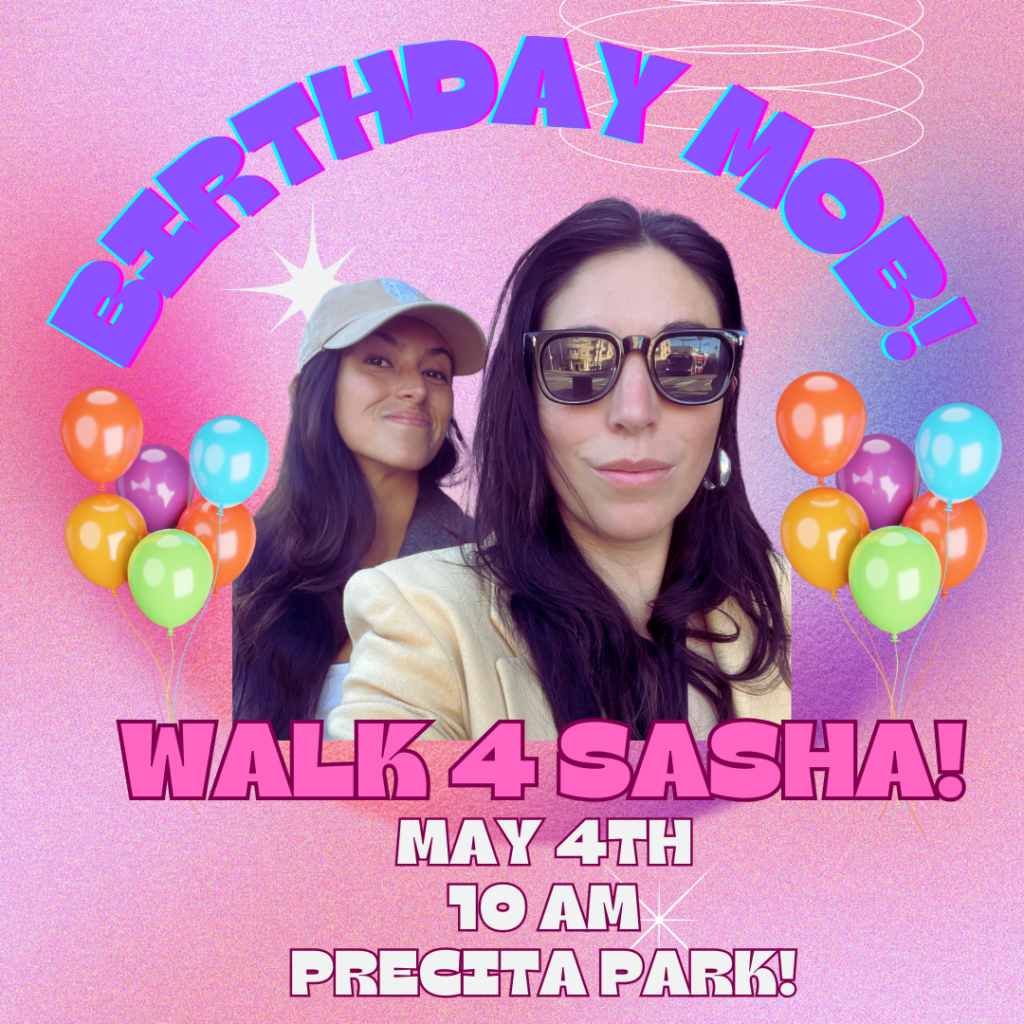
Birthday Mob! Walk 4 Sasha (Jackie Fielder Campaign Mobilization) at Precita Park!
Come walk a door knocking turf for CM Sasha’s birthday 

 on Saturday, May 4 at 10 a.m. at Precita Park!! The gift that keeps on giving is securing District 9 votes for Jackie Fielder
on Saturday, May 4 at 10 a.m. at Precita Park!! The gift that keeps on giving is securing District 9 votes for Jackie Fielder 





Can’t do it Saturday?
Text (502) 930-9500 to get a turf to knock any day of the week!
Homelessness Working Group Sock Distro!
Come join the Homelessness Working Group on Saturday, May 4 at 1:00 p.m. for our sock distro mutual aid project! We’ll be meeting at 1916 McAllister St before heading out to different neighborhoods to pass out socks, sandwiches and hygiene products. Feel free to show up an hour early if you’re able to help prep sandwiches!
 Solidarity with Pro-Palestine Student Protesters for BDS
Solidarity with Pro-Palestine Student Protesters for BDS 
DSA SF stands in solidarity with university student protesters across the country occupying their campuses to demand their administration divest from companies complicit in the apartheid state of Israel.
Israel and the United States continue to perpetrate genocide and enforce apartheid upon the people of Palestine. Universities that use their endowment to invest in and support military contractors and Israeli companies are also complicit.
In response to these protests, universities have called on law enforcement to begin the forcible removal and arrest of students. DSA SF strongly condemns the arrest, suspension, or expulsion of any participating students.
Universities must meet the demands of their students – fully divest from the companies profiting from genocide, apartheid, and occupation in Palestine; institute academic boycotts and sever ties with Israeli universities; and drop all charges against student activists.
Universities and police have allied to support the US’s imperialist ambitions and Zionist settler colonialism. We must all play our part in fighting for a free Palestine.
To support our local student protests, check dsasf.org/events for ongoing mobilizations, and follow your local universities for turnout and donation asks!

Spring Socials with DSA SF 
Come hang out with your friendly neighborhood socialists this spring! For the next few months we will be having a variety of outings and you are invited – be sure to mark your calendars and watch this space for more details! Our next event is a picnic  at Dolores Park on Sunday, May 26 from 12:00 p.m. to 4:00 p.m. and we can’t wait to see you there!
at Dolores Park on Sunday, May 26 from 12:00 p.m. to 4:00 p.m. and we can’t wait to see you there!
The 2024 Chapter Convention is Coming Soon!
It’s all hands on deck as we prepare for the 2024 Chapter Convention this June 15th and 16th! Here are some handy reminders for the next few weeks to help you get ready.
- Nominations for Steering and Grievance Officers are open! Submit your nominations here. Nominations will remain open until the May 8th chapter meeting, and elections will be held at the convention in June.
- April 24th – Deadline to submit bylaws amendments for voting at Convention
- April 28th – Deadline to submit priority resolutions for feedback from Steering
- May 1st – Pre-Convention Info Session and Workshop #2
-
May 8th – May Chapter Meeting
- This is the deadline to submit priority resolutions to steering
- Bylaws amendments concerning voting at Convention must be read to the chapter for consideration at this meeting.
- Annual reportbacks from all chapter bodies
- Nominations close for Steering Committee and Grievance Officers
- First reading on proposed bylaws amendments
- May 16th – Deadline to notify all members of the upcoming convention
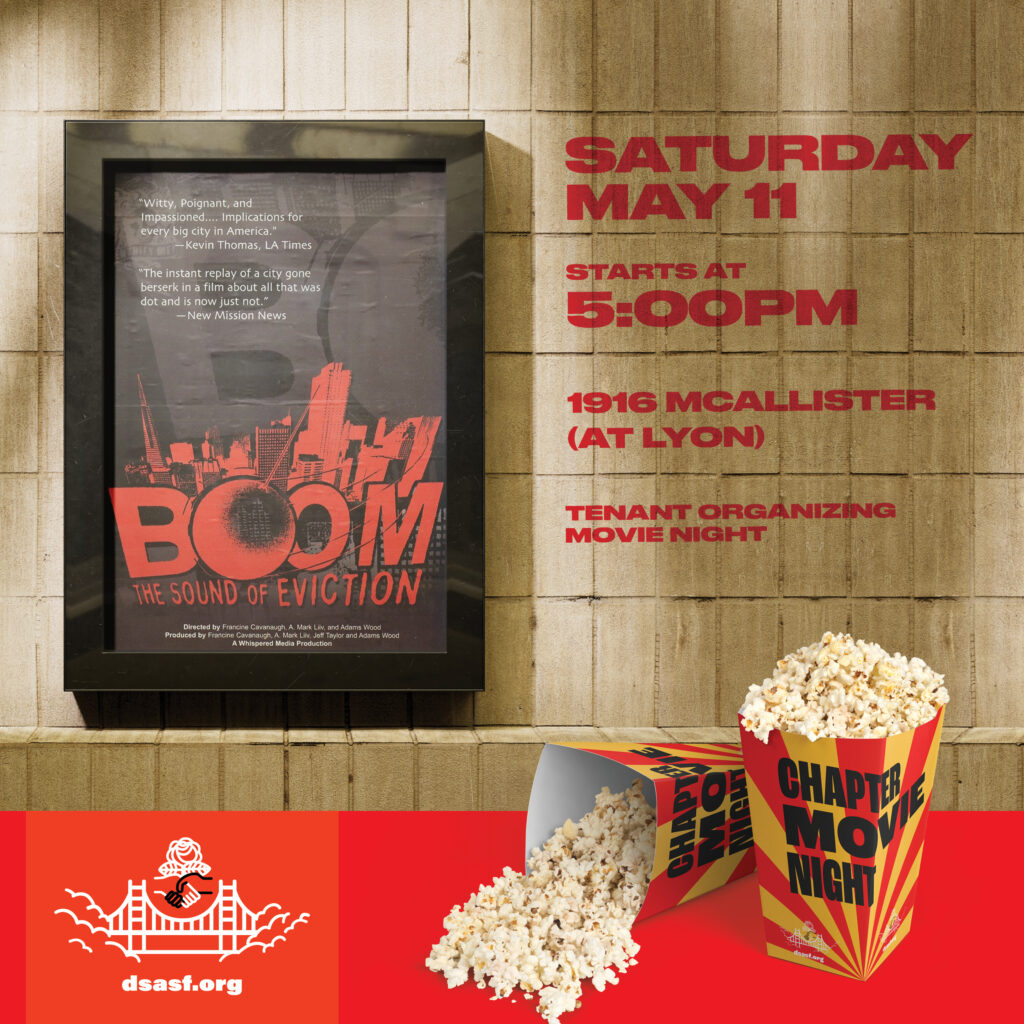
Tenant Organizing Movie Night  Boom: The Sound of Eviction
Boom: The Sound of Eviction
Join the DSA SF Tenant Organizing Working Group for our next movie night on Saturday, May 11th at 5:00 p.m. at 1916 McAllister! We’ll be watching Boom: The Sound of Eviction. While our city’s rulers and the fawning media celebrated the Dot-Com Boom of the ‘90s, the reality was different for thousands of tenants who were evicted or priced out. From the dot-com party crashing at one end of the economic spectrum to painful moments with evicted families at the other, this documentary features interviews with dot-com workers, real estate developers, and San Francisco Mayor Willie Brown, as well as those who challenged the new economic order through community organizing, electoral politics, and direct action.
This event is free and open to the public, and we look forward to seeing you there!

Kickball(s) for Abortion Access on May 18th 
Connect with your neighbors on Saturday, May 18th at 1:00 p.m. while raising money for abortion access! 
San Franciscans don’t need to be reminded that the struggle for bodily autonomy is universal.
 Or, that when someone is denied an abortion it’s more than a hardship for the individual and their family—it’s a test of our community and our commitment to basic human rights. So, let’s put our money where our mouths have been, are, and always will be: BALLS DEEP FOR ABORTION!
Or, that when someone is denied an abortion it’s more than a hardship for the individual and their family—it’s a test of our community and our commitment to basic human rights. So, let’s put our money where our mouths have been, are, and always will be: BALLS DEEP FOR ABORTION! 
We’ll have a friendly fundraising competition, kickball tournament, snack bar, prizes & more! 100% of proceeds will be donated to Texas grassroots abortion access orgs Frontera Fund and Buckle Bunnies (recommended by our comrades at DSA Austin).
For more information about how to get involved, RSVP below!
Behind the Scenes
The Chapter Coordination Committee (CCC) regularly rotates duties among chapter members. This allows us to train new members in key duties that help keep the chapter running like organizing chapter meetings, keeping records updated, office cleanup, updating the DSA SF website and newsletter, etc. Members can view current CCC rotations.
Questions? Feedback? Something to add?
We welcome your feedback. If you have comments or suggestions, send a message to the #newsletter channel on Slack.
For information on how to add content, check out the Newsletter Q&A thread.
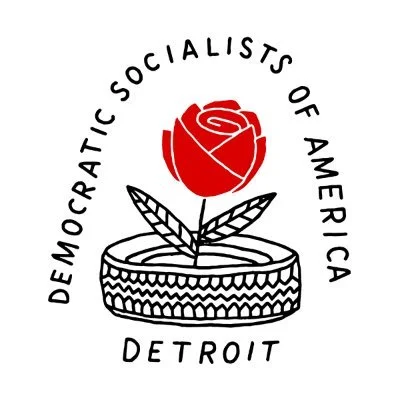

Whose Streets? Our Streets!: A New Gazetteer for Downtown Detroit
As Ron DeSantis and his ilk across the country seek to further enshrine a white supremacist version of history in our schools, libraries, and cultural centers, “organized efforts to document and broadcast the truth of our past are the most significant defense we have against disinformation.”
Place names are an enduring and omnipresent way of remembering the past. The choice of place names informs whose version of history is commemorated and given precedence. Our daily interaction with the names of streets, parks, rivers, and buildings continuously reinforces a specific version of history and consciously and subconsciously informs our relationship to the places we live.
A Brief History of Place-Naming in Michigan
People have been naming places for as long as there have been people in places. Indigenous place names often relate to the intrinsic nature of the land. Teuchasa Grondie, the place of many beavers, is the placename Iroquois speakers call the place we call Detroit, and Maskigong, based on Ojibwe “mashkig” meaning “swamp,” describes the large wetlands at the headwaters of the Maskigong Ziibi (Muskegon River). Descriptive place names value the land for its innate properties and allow for the creation of practical maps that share knowledge of how to get from one place to another, using narrative stories, poetry, and song, as well as pictorial images.
Settler-colonialism brought with it the practice of naming places to claim land ownership. British, French, and Spanish colonizers asserted the collective ownership of their rulers and cultures by naming places for kings and queens, Christian saints, European towns and cities, and famous figures from their history. Hence across the river in Ontario there is a town called London and a river called Thames, and any number of places across the U.S. named for St. _____ and various Charleses, Marys and Georges.
Individual colonizers claimed ownership of land by affixing their names to the places they settled. To give just two of many examples in Michigan: Pellston was named by William Pells in 1882, to claim his ownership of a camp on the Grand Rapids and Indiana Railroad [1], and on the Lake Michigan coast, Bliss was named for Rhoda Bliss, the first white woman to colonize there [2]. Many of the places the colonial settlers slapped their names on already had names. Some of these names were erased and replaced, such as Teuchasa Grondie by Detroit, and some were erased and rewritten in English, such as Maskigong to Muskegon, Michigami to Michigan, and Michinimakinaang to Mackinaw.
Later settlers took over not only Anishinaabe land but also Anishinaabe language to name places. Peter White, iron mining tycoon, appropriated the Anishinaabemowin word “ni-ga-ni” meaning “he walks foremost or ahead,” and anglicized it to Negaunee, to name a colonial settlement on the Upper Peninsula in honor of the “pioneer” ore furnace in the region. Henry Schoolcraft, U.S. “Indian Agent” in Michigan, who incidentally has a street named after him in Detroit, made up place names by combining Anishinaabemowin and Latin. For instance, Arenac is a combination of Latin “arena” meaning sand and Ojibwe “ac” meaning land or earth, made up by Schoolcraft to mean “sandy land” or “sandy place.” Some other Schoolcraft-appropriated names include Alcona, Alpena, Iosco, Kalkaska, Oceola, and Oscoda. Before assuming that a place name is Indigenous in Michigan it is worth researching to ensure it was not made up by Henry Schoolcraft [3].
Place naming for individuals did not just rename the land, it redrew the map. Instead of explaining, verbally or pictorially, how to get from A to B by describing the features of the land, maps now facilitated navigation using the names of the local colonizers. This orientation around ownership claims removed a layer of connection to the land as people walked or rode along the path navigating, not by the wetlands at the headwaters of the river, but by Pells’ Railroad Camp.
Redrawing the map erased and rewrote history. Many books, blogs, historical societies, websites, and Wikipedia posts have been dedicated to the stories of settlers who named places for themselves. All these sources, directly or indirectly, legitimize colonizers’ land ownership claims and orient us to place from a settler colonial perspective. Trying to dig beneath the layers of William Pellses, Rhoda Blisses and Arenacs to learn the original place names and the stories of the people who called them home is not an easy task.
A New Gazetteer for Downtown Detroit
To visit downtown Detroit is to be immersed in a space created to laud a specific version of the city’s past and perpetuate a vision of the future where that vision is seen to be the natural, and only possible, order of things. This space is created using monuments, statues, parks, fountains and, most ubiquitously, street names. In his work on the naming of Martin Luther King Jr. Streets in the Southern U.S., Derek Alderman notes, “Naming is a powerful vehicle for promoting identification with the past and locating oneself within the wider networks of memory” and “[street names] make the past intimately familiar to people in ways that other memorials cannot [4].”
What does it feel like to move through a land where your place names, language and history have been erased or ignored? For People of European Descent, with our language and history so prolifically and seemingly indelibly inscribed on the land, it is almost impossible to imagine.
This map shows what downtown Detroit would look like if you erased the streets and street names that honor the colonizers. When you go downtown to enjoy the holiday lights, open this map on your phone and, even if you think you know where you are going, try to use it to navigate. While in no way parallel to hundreds of years of human, land, history, and language theft and erasure, may this little exercise give you pause to acknowledge that theft and to recognize the impact of its inscription on the land.
Click here to open the map in ARCGIS
Unlike removing monuments or changing the names of private buildings, such as university halls, changing street names is a hard and expensive task and one that, frankly, we do not have the time to organize around given all the other needs of our communities. We also cannot boycott or divest from street names, they are everywhere; on signposts, maps, your ID, your mail, every form you fill out, your online billing statements, your eventbrite RSVP, and many more.
This Gazetteer asks us to change the conversation by subverting the street name narrative to tell another version/s of our shared history…
Click here to open the map in ARCGIS
This project is not intended to be the final word on street names. I am in no way any more “qualified” to be naming Detroit’s streets than the city’s so called “founders.” My intention is to inspire Detroiters to use street names to tell different narratives of place that expand our learning of history and thus our vision for the future.
In working on this project, I noticed I was only able to find Black and White honorees for the street names. I want to recognize that this is directly related to the legacies of colonialism and imperialism as discussed above, and to the legacy of slavery, which erased the indigenous names of enslaved people, and replaced them with the names of their White enslavers.
If you would like to share an honoree/s (it could be anyone from the past or present, well-known or unsung, a personal hero or a family member, or someone who is both of those things) and their stories for the gazetteer, either for any of the streets on the current map or other Detroit streets, parks, plazas etc., please click here!
[1] Petoskey News Review, 14 April 1966
[2] The Petosky Record, 19 September 1883
[3] Walton, I. (1955). Indian Place Names in Michigan. Midwest Folklore, 5(1), 23–34. https://www.jstor.org/stable/4317501
[4] Alderman, D.H. (2008). Martin Luther King Jr. Streets in the South: A New Landscape of Memory. Southern Cultures. (14)3. 88–105. University of North Carolina Press.
The Detroit Socialist is produced and run by members of Detroit DSA’s Newspaper Collective. Interested in becoming a member of Detroit DSA? Go to metrodetroitdsa.com/join to become a member. Send a copy of the dues receipt to: [email protected] in order to get plugged in to our activities!
Whose Streets? Our Streets!: A New Gazetteer for Downtown Detroit was originally published in The Detroit Socialist on Medium, where people are continuing the conversation by highlighting and responding to this story.
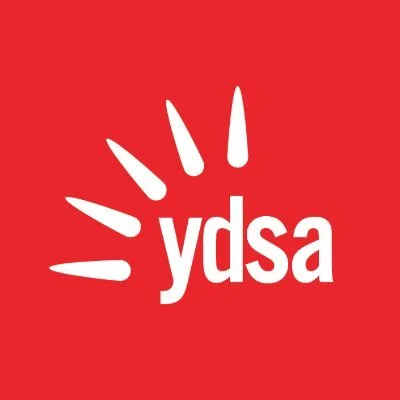
Why Degrowth is Needed
Louie Moore offers a deep dive into degrowth, one potential disruption of capitalist production and capitalist-induced climate change. Degrowth is an economic policy focused on reducing production and consumption within an economy to prioritize a more sustainable economic lifestyle while promoting a cleaner, healthier Earth. The current economy is centered around the idea of “growth,”…
The post Why Degrowth is Needed appeared first on YDSA.

“We’re Going to Free Palestine, and We’re Going to Free the World Too:” Inside the City College Encampment
In an interview for The Activist, Oren Schweitzer talks to Jo von Maack, a key organizer of the Gaza solidarity encampment at City College, about building grassroots support for Palestinian liberation. This past Thursday, April 25, students in the City University of New York (CUNY) system launched a Gaza solidarity encampment on the campus of…
The post “We’re Going to Free Palestine, and We’re Going to Free the World Too:” Inside the City College Encampment appeared first on YDSA.


University of Rochester Students Call for Reversal of Ban on Students Peacefully Protesting on Campus
The following is a press release from students at University of Rochester:
Beginning on Tuesday morning, University of Rochester Students for Justice in Palestine and Students for a Democratic Society took a stand and carried out an encampment to demand that the University fully divest from all academic ties to the apartheid state of Israel, and release a statement calling for a ceasefire to end the suffering of Palestinians in Gaza. This action was not taken lightly but was driven by a deep sense of moral obligation to stand in solidarity with the oppressed people of Gaza, Palestine. Our encampment symbolizes the struggles of millions of Palestinians in Gaza who have been forced to live in tents and sleeping bags after losing their homes due to the ongoing genocide and forced displacement committed by Israel.
Unfortunately, UR has responded to students with dishonesty, threats and repression. We have seen a surge of bans being imposed on UR students restricting freedom of movement on their own campus. These bans have been implemented in an effort to dismantle the encampment, prevent negotiations, and deter us from continuing our peaceful protest, enabling the University to evade accountability.
Five days into our encampment, our reasonable demands to the University of Rochester Administration remain. We continue to call on UR Administration to: (1) join the City of Rochester and Universities across the country in Calling for a ceasefire, and (2) fully divest from all academic ties to the state of Israel. Until the demands are met, or we are forcibly removed, we will remain peacefully on the Eastman Quad, drawing attention to the University of Rochester’s support of apartheid and genocide. Additionally we are now calling upon the University to lift these unreasonable bans and allow us to continue our peaceful protest.
Finally, we share our deepest gratitude with our fellow students, faculty members, alumni, elected officials and the larger Rochester community for standing with us, and for their commitment to the movement for a Free Palestine.
# # #
The post University of Rochester Students Call for Reversal of Ban on Students Peacefully Protesting on Campus first appeared on Rochester Red Star.
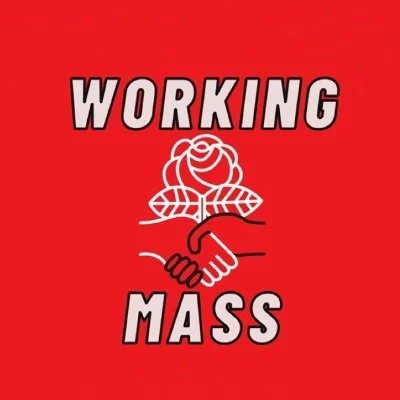

Northeastern Students Arrested Protesting Gaza Genocide – NEU Admin Doubles Down on Disinformation
by Vanessa Bartlett
BOSTON – This morning, over 100 protesters at the Northeastern encampment were arrested after occupying Centennial Common for two days. Students chose to occupy the quad in order to pressure their university to disclose their financial ties to Israel, divest, and denounce Israel’s genocide of Palestinians.

The Northeastern Liberation Zone encampment was bustling with activity ahead of mass arrests
Northeastern University released a statement defending their choice to send police in riot gear after peaceful protesters. The administration claimed that hateful speech was the motivation for the arrests, stating “Last night, the use of virulent antisemitic slurs, including ‘Kill the Jews,’ crossed the line. We cannot tolerate this kind of hate on our campus.”
Working Mass obtained footage of a Zionist counter protester yelling “Kill the Jews!” Organizers did not engage with the provocations, stayed on message and continued to chant pro-Palestinian slogans like “Disclose! Divest! We will not stop, we will not rest!”
Huskies for a Free Palestine (HFP) released a statement this morning, saying “After deploying campus police, city police, and state police on peaceful activist students, Northeastern Administration published an entirely false and fabricated narrative that members of our encampment engaged in hate speech early this morning.”
Wynn, who chose to be identified by their first name only, an organizer with HFP and SJP and a student at Northeastern said, “I feel confident in saying that I think Northeastern knows that statement is a lie.”
“They know what it was like, they had eyes on that scene every moment of every day. If something happened, they knew what happened. And I can’t think of another reason to make the statement so obviously slanted against us,” said Wynn.

Police maintained a presence at Centennial Common throughout the two days of occupation. On the first day, activists successfully prevented Boston Police and Northeastern Police from conducting arrests and dismantling the encampment.
At 12:08 p.m GBH reporter Tori Bedford posted a response she received from Northeastern VP of communications Renata Nyul. “The fact that the phrase ‘Kill the Jews’ was shouted on our campus is not in dispute,” Nyul wrote. “Any suggestion that repulsive antisemitic comments are sometimes acceptable depending on the context is reprehensible.”
Students are calling on Northeastern to issue an apology for punishing students who did not engage in hateful speech.
“Renata Nyul has spread blatant misinformation about myself and my friends, and it is putting myself and my friends in immediate danger from harassment, violence, doxxing and death threats,” said Vivian Dai, a Young Democratic Socialists of America member, who was arrested today.

Police kept legal observers away while protesters were brought into a nearby building, where they were zip-tied and sent to precincts for booking.
“I demand an immediate correction from Nyul so that she can fulfill her duties to protect her students at Northeastern,” said Dai.
It is unclear how many of the counter protesters are affiliated with Northeastern, or if any of the counter protesters caught on video will face criminal charges. Northeastern University has yet to respond to requests for comment on their choice to have student protesters arrested in light of this video, which disproves the narrative shared by the Boston Globe and other news sources.
“I think it’s absolutely mind blowing watching this happen at the school that I go to,” said Wynn, with regard to Northeastern’s hard-line response to the encampment protests. “And I have to assume as a student of capitalist theory that it must just be money, there must be enough money and reputation tied up in Israeli startups and Raytheon, and government programs that there is a large financial and reputation reason to really strongly discourage this kind of action.”
The Boston chapters of Jewish Voice for Peace and If Not Now issued a joint statement in support of the students and denouncing the false claims of antisemitism.
Vanessa Bartlett is a staff organizer for UAW, an editor of Working Mass, and a member of Boston DSA. She has a background in print and radio journalism, but please don’t hold that against her.


Crackdown At Emerson: A Journalist’s First Hand Account
In a narrow alleyway, roughly 200 student protestors stood shoulder to shoulder as riot police streamed in. Their heroic stand should inspire us all.
By Henry De Groot

THEATER DISTRICT – It’s been a long time since anyone called this part of town the Combat Zone. That name recalls a grittier Boston of the 80s and 90s in which peep shows and late night brawls characterized the neighborhood, although these have long since been replaced by throngs of tourists and a Tatte Bakery and Cafe with a view of the Boston Common.
Now this neighborhood – which runs from Downtown Crossing to Tufts Medical Center and centers on the corner of Boylston and Tremont – goes by a nicer, realtor-approved name, which is in no small way related to the liberal arts college, Emerson, which dominates the neighborhood.
Despite the name change, on Thursday morning public workers set out with pressure washers to clean blood off the bricks of Boylston Place, a small pedestrian-only public alley tucked between Emerson buildings.
The blood presumably belonged to one of the more than 100 Emerson students who were arrested after Boston Police forcefully raided the encampment at 2 a.m. Thursday morning. It is hard to tell whose blood it is as no news cameras were rolling to film the police raid; presumably hiding from the cameras was part of the reason why progressive mayor Michelle Wu waited until the early hours of the morning before assembling around 200 riot cops to storm the alley. If not for a few livestreamers and a handful of amateur journalists including Dan Albright, Evan George, and myself, the city may not have woken up to the appalling videos of the mass-arrests.
The Making of A Police Raid
When I stopped by the Emerson encampment on Wednesday afternoon it was beginning to look more and more like a rag-tag military camp.
At the alley’s entry stood 20 students in three lines, standing arm and arm under a black iron gate covered in posters and banners and flying a Palestinian flag. Under the confident direction of a young female student draped in a keffiyeh, the lines of students drilled for the inevitable scrum with police, although they let in campus administrators and passersby. Scouts watched cautiously for cruisers or Zionist provocateurs.
In the alley itself, students attended to the various needs of the encampment, assembling donations of food and blankets at the supply tables, plating out meals, and painting banners of green, black, and red. Since I had visited the day before, students had strung up tarps over the tents in defense against the cold rains of late April, and two students struggled to secure them as a harsh wind whipped through the alleyway. Some students played cards, huddling under donated blankets.
It was not obvious to me that the camp would be stormed when I headed home at 10 in the evening. The Boston Globe had reported that police were warning of an impending action, but that might not come for several days. But just as soon as I arrived home, I got word that help was needed back at camp. Arriving by car, I saw a line of around a dozen vehicles from the Massachusetts State Police parked on Charles Street, as well as a few trucks from the Fire Department.
The back of Boylston Place leads to an entrance to the State Transportation Building. And that was where around a dozen state troopers in hi-viz jackets assembled, far too few to make an incursion into the protest, but too many to be there for any other reason. Walking on foot to the Charles Street side of the building, I waved through the window to a Statie parked on the street. Using some Boston intonations I learned while working at Dunkin Donuts asked him, “When you guys arrest the students, where are you going to take them?”
“It’s BPD’s show,” he replied, confirming my suspicions of an imminent action. “Probably to A1.”
I returned to warn the students. They could see the Staties through the windows of the State Transportation Building, and were growing increasingly agitated.
I doubled back to Charles Street to wait for police reinforcements. BPD cruisers began arriving and officers entered the building in ones and twos, carrying helmets and armor in large duffel bags.
Once again I returned to the encampment, where I joined up with Dan. The protestors had sealed off the front gate, so Dan and I ducked down a side alley which led us around in front of the back line of protestors. Out of nowhere, a dozen open umbrellas had appeared, held by the first line of students to protect them from projectiles. In front of them, they had raised a thin barricade of picnic tables and trash barrels. I slipped behind the line into the middle of the encampment.
“Have you ever been tear gassed? What’s it like?” asked a nervous sophomore.
“It’s pretty intense,” I replied, not wanting to lie. “It gets in your eyes and lungs all at once and can be pretty overwhelming.”
“Oh,” he responded quietly.
“You’ll be okay,” I said, trying to sound convincing.
From All Sides And All At Once
Suddenly there was a commotion at the front gate, and Dan and I rushed over. I climbed up the iron frame of the right side of the gate, poking my head and camera through so I could see what was happening on the street.
A line of police vans had pulled up and a large number of riot police were forming up. A police officer read out a city ordinance over the loudspeaker of a parked cruiser; I struggled to make out his words although I was only 15 feet away, as the loudspeaker was drowned out by chants. I later learned that it was the anti-homeless ordinance passed in 2023 which banned setting up tents in public ways.
“FREE FREE PALESTINE!”
Running and posting my footage to social media simultaneously, I rushed back to the rear line, hopping up on a picnic table for a better view. From behind, there was shouting and I could see that the front line was under siege and quickly folding. “Here they come!” I shouted.
Calm and authoritative, a student yelled, “Back line! Reinforce!” A dozen students hurried to reinforce the front gate in reasonable order despite the growing cacophony.
Turning back to the rear of the alley, I looked over the heads of the protestors as 50 or so riot police stormed out of the transportation building and headed towards us. The burly officers made quick work of the barricades in front of the student protestors, and in an instant they were upon the front line of students.
The next 90 seconds were a blur as police immediately began tugging on protestors, pulling them away from the arms of their comrades and tossing them on the floor, twisting their wrists into waiting zip-ties.
Students pressed back into the table I was standing on, which started to wobble violently. I hopped down, trying to post the footage I had just taken in case I was arrested. I had time to type three words, “Mass Arrests Begin,” and prayed that the video would upload correctly.
Not intending to be arrested, I leaped over bags of blankets as I tried to make for the side-alley, but a cop was already blocking it. The police were on me, and I shouted “press! press! I’m a journalist” as I wove my way through them. A cop grabbed me and pushed me out of the alley and past the police lines on the sidewalk out front. Later I learned that Dan, who was only 10 steps behind me, was not so lucky.
Out front, police were loading students into police vans. But the students would not go silently in the night, and the rhythmic thumping and chanting from protestors inside the vans filled the street loudly.
“WE KEEP US SAFE! WE KEEP US SAFE!”
It did not take long for the police to usher away more than 100 arrested students. Only a few onlookers, a recently arrived camera man from the local news, and myself remained, and still for hours the riot police cordoned off the street.
As dawn approached, the alley bore witness to the aftermath of the clash. The banners at the gate were torn, and broken zip ties and empty water bottles litter the ground. But still, over the gate, a Palestinian flag flew proudly.
The Battle of Boylston Place
The worn tombstones of the Central Burying Ground stand directly opposite from Boylston Place. Many of them mark the bodies of colonists and British soldiers alike who fought at the Battle of Bunker Hill.
At that battle, the colonists famously proved not that they could defeat the British in open combat, but that at least they could go toe-to-toe with the most powerful military on Earth. Although they inflicted heavy British casualties, they ultimately retreated; but the real victory was one of morale – the heroic stand of the soldiers at Bunker Hill, their heroic sacrifices, inspired thousands more to join their ranks.
Three days of drilling in formation did not create a force of students strong enough to repel the riot police, but it did create a force strong enough to stand toe-to-toe and resist en-masse.
And perhaps since the first day that Emerson students set up their tents, it was inevitable that they too would have their heroic stand. The alleyway was always a terribly indefensible position, but the close quarters had the benefit of steeling the students’ resolve. Three days of drilling in formation did not create a force of students strong enough to repel the riot police, but it did create a force strong enough to stand toe-to-toe and resist en-masse.
The protest at Emerson College may have been quelled by force, but its impact reverberates far beyond the confines of the alleyway. The stories of the students heroic stand and the videos of the terrible police raid are inspiring thousands of students around the country, recalling images of the protests against Vietnam, as little Emerson joins the proud ranks of Columbia, University of Texas, Yale, and other campuses which have squared off with police in defiance of genocide. Emerson serves as a rallying cry for justice, inspiring a new generation to stand firm in the face of oppression and tyranny.
All that was missing for the students to fulfill such a heroic and historic role was an order for the police to clear them out. Mayor Wu was happy to oblige.
Despite never having experienced the hardship of the people living under bombardment in Gaza, students took it into their own hands to demand that their institutions stop profiting from genocide.
Henry De Groot is the Managing Editor of Working Mass, a member of Boston DSA and the Reform and Revolution caucus. He was a member of SJP at UCLA, and is the author of the book “Student Radicals and the Rise of Russian Marxism.”


Solidarity with the Student Movement and the Gaza Solidarity Encampments
DSA stands in unwavering solidarity with the students across Columbia, Yale, NYU, Vanderbilt, Cal Poly, University of Michigan and the dozens of rapidly developing encampments at campuses across the country. The victories of the student movement are incumbent upon the victories and wins of Palestinian student groups, and we pledge to fight alongside them for a free Palestine as they face increasingly unprecedented repression from the state. These wins are a precedent for our movement as a whole, and follow a decades-long tradition of students putting their bodies on the line to stop the ravages of imperialism and the military-industrial complex, such as the movements against the Vietnam War, South African apartheid, and the Iraq War.
We support the righteous message of protesters at the encampments. We call on our comrades to support efforts nationwide to force universities to divest from the Zionist occupation and call on the United States government to cease all aid to Israel. Where protests appear, we’ll appear in numbers. Where repression looms, we’ll show up and protect the whole. Where support is needed, we’ll be a support.
As socialists, we must not lose sight of our fight for the urgent stop to the genocide in Gaza and the liberation of Palestine, from the river to the sea. We commend the student movement on re-igniting the streets and we will fight by their side, shoulder to shoulder, to force all our institutions to divest from the Zionist settler colonial project, end all aid and arms to Israel, and for the complete and full liberation of Palestine.
*Laws vary by state, and we encourage event organizers and participants to contact your local region of the National Lawyers Guild for guidance on how to protect protesters.
The post Solidarity with the Student Movement and the Gaza Solidarity Encampments appeared first on Democratic Socialists of America (DSA).
 May Day Action!
May Day Action! 

 Boom: The Sound of Eviction
Boom: The Sound of Eviction An Emerson College student recorded this video of city crews cleaning up blood from the alley where 108 students were arrested last night
An Emerson College student recorded this video of city crews cleaning up blood from the alley where 108 students were arrested last night